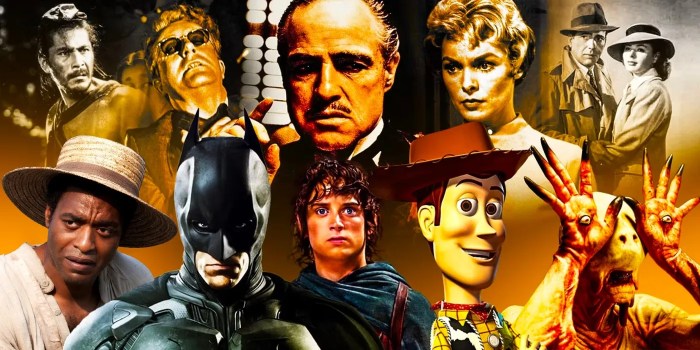Movie advertisements, encompassing trailers, posters, and online campaigns, play a crucial role in shaping public perception and driving ticket sales. This guide delves into the history, strategies, and future of movie advertising, examining its evolution, effectiveness, and impact on audiences.
From the early days of cinema to the current digital landscape, movie advertising has undergone a significant transformation. This comprehensive analysis explores the diverse elements contributing to successful campaigns, encompassing content, design, and the crucial metrics used to gauge effectiveness.
Introduction to Movie Advertisements

Movie advertisements are a crucial component of the film industry, encompassing a diverse range of promotional materials designed to attract audiences and generate interest in upcoming releases. These advertisements span across various mediums, from captivating trailers and eye-catching posters to targeted online advertisements and social media campaigns. Their purpose is to effectively communicate the film’s essence, genre, and intended appeal to potential viewers.The evolution of movie advertising mirrors the broader evolution of media.
Early methods relied heavily on posters and print advertisements, often featuring dramatic illustrations and compelling narratives. The advent of television ushered in the era of television commercials, and more recently, the rise of digital platforms has revolutionized how films are promoted, allowing for more nuanced targeting and interaction with audiences. This evolution reflects a continuous adaptation to evolving audience preferences and technological advancements.
Target Audience Identification
Identifying the target audience is paramount for effective movie advertising. This process involves market research, demographic analysis, and audience segmentation. Factors like age, gender, cultural background, and interests are considered. For example, a family-friendly animated film would target families with young children, while an action-packed thriller might focus on a more mature audience. Understanding these nuances allows filmmakers to tailor their promotional materials to resonate with the specific groups most likely to enjoy the film.
Successful campaigns often incorporate detailed audience profiles to maximize their impact.
Effectiveness of Advertising Mediums
Different advertising mediums offer varying degrees of reach and impact. A comprehensive approach often combines multiple platforms to maximize exposure. The effectiveness of a particular medium hinges on factors like the target audience, budget, and overall marketing strategy. For example, a television spot can reach a wide audience but can be expensive, whereas social media ads allow for highly targeted campaigns, though with a potentially narrower reach.
| Advertising Medium | Strengths | Weaknesses | Effectiveness (Example) |
|---|---|---|---|
| TV Spots | Broad reach, high impact visuals, established trust | High cost, limited targeting, potential for ad fatigue | A well-produced trailer shown during a popular primetime show can generate significant buzz and ticket sales. |
| Social Media Ads | Highly targeted, interactive engagement, relatively low cost | Limited reach compared to TV, requires constant monitoring and optimization, susceptibility to algorithm changes | A series of targeted Instagram posts showcasing behind-the-scenes footage and interviews can build anticipation and generate online discussion. |
| Print Posters | Tangible, visually impactful, memorable | Limited reach, static nature, difficult to track results | Eye-catching posters placed in high-traffic areas can generate awareness and create a lasting impression, especially for smaller independent films. |
| Online Trailers | Measurable results, targeted ads, engagement with reviews and discussions | Requires a robust online presence and strong strategies, relies on audience’s willingness to actively search | A film’s trailer released on YouTube can generate millions of views and significantly boost the film’s visibility before its release. |
Content and Design Strategies

Movie advertisements are meticulously crafted to capture the audience’s attention and pique their interest in the film. Effective advertising campaigns utilize a blend of compelling visuals, engaging sound design, and strategically employed narrative techniques. Understanding the specific strategies employed in advertising different types of films is crucial for maximizing their impact.Successful movie advertisements often employ a combination of strong visuals and persuasive narratives.
This is especially important considering the sheer volume of media vying for consumer attention. The advertisements need to stand out, communicating the essence of the film quickly and effectively. The targeted approach to different film genres further enhances the impact.
Elements of Compelling Movie Advertisements
Advertisements for films need to convey the film’s essence rapidly and efficiently. This requires a combination of attention-grabbing visuals, sound design that amplifies the narrative, and strategically employed narrative techniques. A successful advertisement should generate intrigue and desire to see the film.
- Visuals: High-quality cinematography, compelling shots, and visually striking imagery are crucial. Consider the use of vibrant color palettes, creative camera angles, and impactful set designs. For example, a blockbuster film might feature spectacular action sequences, while an independent film might emphasize character interactions and emotional depth through close-ups.
- Sound Design: Sound plays a vital role in setting the mood and tone of the advertisement. The use of music, sound effects, and dialogue should create an immersive experience that complements the visuals and enhances the narrative.
- Narrative Techniques: Storytelling techniques are essential for capturing the audience’s attention. The advertisement should hint at the film’s plot, characters, and themes without revealing the entire story. Suspenseful trailers, for instance, build anticipation for the film’s release. This often involves carefully selected plot points and character interactions.
Comparison of Advertising Campaigns
Different film genres require different approaches in their advertising campaigns. The advertisements need to align with the film’s target audience and overall message. Blockbusters often rely on action-packed sequences and high-octane visuals, while independent films might prioritize character development and emotional connection.
- Blockbusters: Blockbuster advertisements typically focus on spectacle, showcasing action sequences, special effects, and impressive visuals. They often utilize a fast-paced montage of key scenes to generate excitement and a sense of wonder. For example, the advertisements for “Avengers: Endgame” prominently featured iconic characters and intense action scenes.
- Independent Films: Independent films often focus on character interactions and emotional depth. Their advertisements might emphasize specific performances, poignant dialogue, and the film’s thematic elements. For example, advertisements for “Moonlight” focused on the characters’ journeys and emotional arcs.
- Animated Films: Animated films often use vibrant colors, dynamic animation styles, and catchy music to create a playful and engaging atmosphere. Advertisements might focus on the film’s unique characters and their interactions. The advertisements for “Toy Story 4” effectively communicated the film’s emotional depth and humor through its character interactions and animation style.
Storytelling Techniques in Movie Advertisements
Advertisements utilize various storytelling techniques to create intrigue and anticipation. These techniques effectively communicate the film’s plot, themes, and emotional core to the audience.
- Mystery and Suspense: Advertisements employing mystery and suspense often feature cryptic visuals, intriguing dialogues, and enigmatic soundtracks. They leave the audience wanting to know more, creating anticipation for the film’s release. For instance, the trailers for “The Sixth Sense” used fragmented scenes and unsettling sound to build suspense.
- Comedy: Advertisements for comedic films often use humor to showcase the film’s lighthearted tone and characters. They might use comedic scenarios, witty dialogue, and slapstick moments to create a sense of enjoyment and anticipation. Consider the use of humorous situations and reactions in the advertisements for “The Hangover.”
- Romance: Advertisements for romantic films often focus on tender moments, passionate interactions, and evocative music. They aim to evoke feelings of love, longing, and connection. For example, advertisements for “Titanic” showcased passionate scenes and heartwarming interactions between the characters.
Visual and Sound Design Examples
Successful movie advertisements often employ specific visual and sound design choices to create a strong impact. Color palettes, fonts, and soundtracks can be crucial in conveying the film’s mood and themes.
- Visual Examples: A dark and moody color palette might be used for a thriller, while a vibrant and energetic palette might be used for a comedy. Specific camera angles, framing, and lighting can also evoke particular emotions and create a particular mood. For example, a close-up shot on a character’s face can convey emotional depth.
- Sound Design Examples: A suspenseful soundtrack with dramatic music and eerie sound effects can be used to create anticipation and tension. A comedic soundtrack with upbeat music and humorous sound effects can be used to create a lighthearted atmosphere. Sound design can greatly impact the emotional impact of the advertisement.
Narrative Structures in Movie Advertisements
Different narrative structures are employed in movie advertisements to convey specific themes and emotions.
| Narrative Structure | Description | Example |
|---|---|---|
| Mystery | Advertisements that create intrigue and suspense by revealing only fragments of the story. | “The Sixth Sense” |
| Suspense | Advertisements that build tension and anticipation through carefully selected scenes and sound design. | “The Silence of the Lambs” |
| Comedy | Advertisements that use humor and lighthearted moments to showcase the film’s comedic tone. | “Bridesmaids” |
| Romance | Advertisements that focus on tender moments, passionate interactions, and evocative music. | “When Harry Met Sally…” |
Font and Color Choices in Movie Advertisements
Font and color choices play a crucial role in creating a particular mood and evoking specific emotions.
| Font | Color | Emotion/Mood | Example |
|---|---|---|---|
| Bold, sans-serif | Red, orange | Excitement, energy | Blockbuster trailers |
| Cursive, script | Pink, lavender | Romance, nostalgia | Romantic comedies |
| Serif, elegant | Blue, gray | Mystery, sophistication | Thrillers, dramas |
Advertising Goals and Metrics
Movie advertisements aim to achieve a range of objectives, from generating initial excitement and buzz to directly driving ticket sales and bolstering brand recognition for the studio. Understanding these goals and the metrics used to assess their success is crucial for optimizing future campaigns. Effective measurement ensures that advertising dollars are allocated efficiently and contribute meaningfully to the overall film’s success.A comprehensive evaluation of movie advertisement effectiveness necessitates a multi-faceted approach.
This involves scrutinizing various factors, including the campaign’s reach, audience engagement, and ultimate impact on ticket sales and brand perception. Success is not simply defined by the number of views or impressions but rather by how effectively the campaign translates into tangible results.
Primary Objectives of Movie Advertisements
Movie advertisements are designed to achieve specific objectives, impacting audiences in various ways. These include generating pre-release buzz and anticipation, driving ticket sales, enhancing brand awareness for the studio, and increasing the film’s overall visibility. These goals, carefully aligned with the film’s target audience and marketing strategy, are essential for maximizing the campaign’s return on investment.
Measuring Movie Advertisement Effectiveness, Movie advertisements
Movie advertisement effectiveness is measured using a variety of metrics, each providing a unique perspective on the campaign’s performance. These metrics encompass reach, engagement, and conversion rates. Quantifiable data, like impressions and click-through rates, offer insights into the campaign’s overall impact, while qualitative data, such as social media engagement and online discussions, reveals audience sentiment and response to the advertising.
Metrics for Evaluating Campaign Success
Several metrics are instrumental in assessing the success of a movie advertising campaign. These metrics include impressions, click-through rates (CTR), social media engagement (likes, shares, comments), website traffic, and, ultimately, box office revenue. A comprehensive analysis of these metrics provides a holistic understanding of the campaign’s performance and its impact on key objectives.
Relationship Between Advertisement Spending and Film Revenue
There’s a complex relationship between advertising expenditure and film revenue. While a significant advertising budget can generate considerable buzz and awareness, it doesn’t guarantee box office success. The effectiveness of the advertising campaign, the film’s quality, and factors like competition and release timing all contribute to the final outcome. Successful campaigns often find an optimal balance between advertising spending and overall ROI.
Examples include high-profile films that leverage substantial marketing budgets for extensive campaigns, often exceeding their return in terms of ticket sales and ancillary revenue streams.
Examples of Successful Movie Advertising Campaigns
Several successful movie advertising campaigns effectively achieved their stated objectives. For instance, the marketing strategy for a film like “Avatar” involved a multi-platform approach, leveraging social media, television, and print advertisements to create significant pre-release anticipation. This generated substantial buzz and ultimately contributed to its phenomenal box office success. Another successful example is the campaign for “The Avengers,” which strategically employed a combination of targeted advertising and social media engagement to drive ticket sales and establish a strong brand identity for the Marvel Cinematic Universe.
Key Performance Indicators (KPIs) for Measuring Movie Ad Performance
| KPI | Description | Measurement Method |
|---|---|---|
| Impressions | Number of times an ad was displayed | Ad serving platforms, analytics tools |
| Click-Through Rate (CTR) | Percentage of viewers who clicked on an ad | Tracking clicks from ads to landing pages |
| Social Media Engagement | Interactions (likes, shares, comments) on social media | Social media analytics dashboards |
| Website Traffic | Number of visitors to the film’s website | Website analytics platforms |
| Box Office Revenue | Total revenue generated from ticket sales | Box office reporting systems |
| Brand Awareness | Increased recognition of the film and studio | Surveys, brand tracking studies |
Influence and Impact of Movie Advertisements

Movie advertisements play a crucial role in shaping public perception and influencing box office success. They act as a vital bridge between the creative vision of filmmakers and the public’s eventual experience. These advertisements are carefully crafted to evoke specific emotions and expectations, aiming to entice potential viewers and drive ticket sales.Understanding the mechanisms through which movie advertisements function is essential to appreciating their profound influence on the film industry.
Their impact extends beyond mere promotion; advertisements actively participate in the construction of a film’s public image, often dictating audience expectations and potentially even altering the way the film is ultimately perceived.
Audience Perception and Expectations
Movie advertisements meticulously cultivate specific audience expectations. By selectively highlighting certain aspects of a film – be it the plot, characters, or visual style – advertisements create a pre-conceived notion of the viewing experience. This carefully curated portrayal can significantly influence how viewers interpret the film itself, potentially leading to heightened anticipation or, conversely, disappointment. For example, a trailer emphasizing action sequences might predispose viewers to expect a high-octane, fast-paced film, which could affect their overall satisfaction if the movie deviates from this initial impression.
Shaping the Public Image of a Film
Advertisements act as the primary vehicle for constructing a film’s public image. The carefully chosen visuals, dialogue, and narrative snippets in trailers and posters establish a particular tone and style, effectively painting a picture of the film for potential audiences. This image-building process is vital, as it sets the stage for viewer expectations and influences their ultimate decision to see the movie.
A film marketed as a heartwarming family drama, for instance, will likely attract a different audience demographic than one presented as a gritty crime thriller.
Cultural Trends and Advertising Strategies
Cultural trends exert a considerable influence on movie advertising strategies. Trends in fashion, music, and societal values often shape the imagery, dialogue, and overall aesthetic of movie advertisements. For example, a film released during a period of heightened social awareness might feature themes and imagery that reflect these contemporary concerns. Likewise, current trends in technology or visual effects can be incorporated to attract viewers accustomed to a particular aesthetic.
Potential Misrepresentation of Film Content
While advertisements aim to entice viewers, they sometimes inadvertently or intentionally misrepresent the film’s content. This can occur when trailers focus on action sequences or humorous moments while downplaying the emotional depth or complexity of the story. Furthermore, overly dramatic or sensationalized portrayals can create expectations that may not be fulfilled in the actual movie, leading to potential disappointment.
A compelling example would be a trailer emphasizing a romantic subplot that is ultimately less significant in the movie itself.
Demographic Impact of Movie Advertisements
Advertisements’ impact varies significantly across different demographics. Children’s films, for instance, are often marketed with a vibrant and playful aesthetic, appealing to younger audiences. On the other hand, films targeting adults may employ a more mature and nuanced approach. Furthermore, cultural background and personal interests can influence how advertisements resonate with different groups. For example, a movie advertised using a specific slang or cultural reference may not appeal to all audiences, showcasing the inherent differences in the impact of advertisements on different groups.
Ethical Considerations
Ethical considerations surrounding movie advertisements are paramount. The potential for misleading viewers regarding the film’s content necessitates careful consideration. The use of manipulated footage, misleading dialogue, or incomplete portrayals can deceive potential viewers and undermine trust. Transparency and honesty in representing the movie are essential, ensuring that audiences are presented with a fair representation of what to expect.
Future Trends in Movie Advertising

The landscape of movie advertising is constantly evolving, driven by technological advancements and shifting consumer behaviors. As audiences engage with media in increasingly diverse and personalized ways, advertisers must adapt their strategies to remain effective. This necessitates a proactive approach to understanding and anticipating future trends, enabling them to connect with target audiences more meaningfully.Emerging technologies, data analytics, and changing consumer preferences are profoundly shaping the future of movie advertising.
These evolving factors necessitate a proactive approach, enabling advertisers to tailor their strategies to resonate with modern audiences.
Emerging Technologies and Platforms
Movie advertisements are leveraging innovative platforms and technologies to reach wider audiences and enhance engagement. Virtual Reality (VR) and Augmented Reality (AR) are transforming the way audiences experience trailers and pre-release promotions. Interactive ads, which allow viewers to actively participate in the advertisement experience, are gaining traction. These advancements offer a more immersive and engaging experience compared to traditional methods.
Data Analytics and Personalization
Data analytics are crucial in tailoring movie advertisements to specific audiences. By analyzing viewer data, including preferences, viewing history, and demographics, advertisers can create highly personalized advertisements. This targeted approach ensures that viewers are exposed to content relevant to their interests, thereby maximizing the effectiveness of the advertisement. Examples include targeted ads for specific genres or actors, personalized recommendations, and the ability to adjust ad content in real-time based on viewer feedback.
Social Media and Influencer Marketing
Social media platforms have become essential channels for movie advertising, enabling direct engagement with target audiences. Influencer marketing leverages the credibility and reach of social media influencers to promote films to their followers. This strategy allows advertisers to reach specific demographics and build brand awareness in a cost-effective manner. For instance, movie studios partner with gaming influencers to promote action films, or beauty influencers to promote dramas with a focus on female protagonists.
Future Predictions and Potential Uses
The future of movie advertising will be marked by increased personalization, integration of interactive technologies, and enhanced data-driven decision-making.
| Emerging Technology | Potential Use in Movie Advertising |
|---|---|
| Virtual Reality (VR) | Immersive trailers, interactive experiences allowing viewers to virtually explore film settings or interact with characters. |
| Augmented Reality (AR) | Overlays that enhance the viewing experience, for example, adding characters or effects to real-world locations or enabling interactive games related to the movie. |
| Interactive Ads | Quizzes, polls, or mini-games integrated into advertisements that allow viewers to engage with the content and potentially win prizes. |
| Personalized Recommendations | Algorithms that analyze viewer data to recommend movies based on past viewing habits and preferences, potentially increasing the likelihood of viewers discovering new films. |
| Data Analytics | Targeted advertising campaigns that cater to specific demographics, interests, and viewing habits. Real-time adjustments to ad campaigns based on viewer responses. |
Final Conclusion: Movie Advertisements

In conclusion, movie advertisements are more than just promotional tools; they are sophisticated marketing strategies that shape public perception and influence box office success. Understanding their evolution, content strategies, and future trends is critical for anyone involved in the film industry. The meticulous analysis presented here offers valuable insights into the intricate world of movie advertising.
General Inquiries
What are the key differences between advertising for a blockbuster and an independent film?
Blockbuster films often leverage larger budgets for extensive campaigns across various media, emphasizing spectacle and mass appeal. Independent films, with smaller budgets, often focus on targeted marketing and building buzz through unique approaches, leveraging social media and word-of-mouth.
How can movie advertisements be used to create anticipation and generate excitement?
Effective movie advertisements employ storytelling techniques, showcasing compelling visuals and sound design to pique interest. They often use suspense, mystery, or humor to create a sense of intrigue and build anticipation for the film’s release.
What are some ethical considerations in movie advertising?
Ethical considerations include avoiding misleading content that inaccurately portrays the film’s storyline or tone. It’s essential to be transparent and honest about the film’s content, while also respecting potential sensitivities within the target audience.
How do cultural trends influence movie advertising strategies?
Cultural trends play a significant role in shaping movie advertising strategies. Advertisements often reflect contemporary social and cultural values, using relevant imagery and language to resonate with the target audience.



